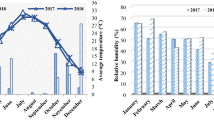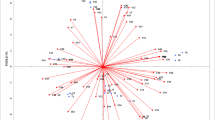Abstract
The effect of harvest periods on total phenol, antioxidant activity, individual phenolic compounds of fruit and leaves of Tavşan Yüreği, Memecik, Edremit, Ayvalık and Gemlik olive varieties grown in Turkey were investigated. The highest total phenol (317.70 mg/100 g and 2657.81 mg/100 g) were observed in Tavşan Yüreği olive fruit and Ayvalık leaves harvested in December, respectively. The highest antioxidant activities (83.84%) were determined in Edremit fruit harvested in August and 83.33% in either Edremit olive leaves harvested in November and Tavşan Yüreği leaves harvested in December. The olive fruit contained gallic acid ranging from 7.18 mg/100 g (August) to 35.85 mg/100 g (December) in case of Ayvalık and 2.09 mg/100 g (November) to 21.62 mg/100 g (December) in Edremit. Gemlik olives showed higher gallic acid contents compared to the other varieties, however it depended significantly on harvest time in all cases. 3,4-Dihydroxybenzoic acid contents ranged from 33.11 mg/100 g (October) to 25.17 mg/100 g (September) in Memecik olives; 12.17 mg/100 g (August) to 33.11 mg/100 g (December) in case of Tavşan Yüreği olives depending on harvest time. The 3,4-dihydroxybenzoic acid contents of Memecik leaves ranged between 122.25 mg/100 g (September) to 196.58 mg/100 g (August) and that of Tavşan Yüreği leaves changed between 99.38 mg/100 g (November) and 179.90 mg/100 g (August). The leaves of these two varieties contained significantly (p < 0.01) higher 3,4-dihydroxybenzoic acid contents than other varieties. The highest gallic acid (144.83 mg/100 g) was detected in Memecik leaves (September) whereas lowest were found in Gemlik leaves collected in October.


Similar content being viewed by others
References
Al-Rimawi F, Odeh I, Bisher A, Abbadi J, Qabbajeh M (2014) Effect of geographical region and harvesting date on antioxidant activity, phenolic and flavonoid content of olive leaves. J Food Nutr Res 2(12):925–930
Andrews P, Busch JLHC, Joode T, Groenewegen A, Alexandre H (2003) Sensory properties of virgin olive oil polyphenols: identification of deacetoxy-ligstroside aglycon as a key contributor to pungency. J Agric Food Chem 51:1415–1420
Arslan D (2010) Güney Anadolu’da Yetisen Bazı Yaglık Zeytin Çesitlerinin ve Yaglarının Fiziksel ve Biyokimyasal Özellikleri Üzerine Lokasyon ve Hasat Zamanının Etkisi. Doktora Tezi. Selçuk Üniversitesi, Fen Bilimleri Enstitüsü, Gıda Mühendisligi Anabilim Dalı, p 249, Konya
Benavente-Garcıa O, Castillo J, Lorente J, Ortuno A, Del Rio J (2000) Antioxidant activity of phenolics extracted from Olea europaea L. leaves. Food Chem 68(4):457–462
Brahmi F, Mechri B, Dhibi M, Hammami M (2013) Variations in phenolic compounds and antiradical scavenging activity of Olea europaea leaves and fruits extracts collected in two different seasons. Ind Crops Prod 49:256–264
Briante R, La Cara F, Febbraio F, Patumi M, Nucci R (2002a) Bioactive derivatives from oleuropein by a biotransformation on Olea europaea leaf extracts. J Biotechnol 93:109–119
Briante R, Patumi M, Terenziani S, Bismuto E, Febbraio F, Nucci R (2002b) Olea europaea L. leaf extract and derivatives: antioxidant properties. J Agric Food Chem 50:4934–4940
Cerretani L, Bendini A, Del Caro A, Piga A, Vacca V, Caboni MF, Toschi TG (2006) Preliminary characterization of virgin olive oils obtained from different cultivars in Sardinia. Eur Food Res Technol 222(3–4):354–361
Dağdelen A, Tumen G, Özcan MM, Dundar E (2013) Phenolics profiles of olive fruits (Olea europaea L.) and oils from Ayvalik, Domat and Gemlik varieties at different ripening stages. Food Chem 136:41–45
El SN, Karakaya S (2009) Olive tree (Olea europaea) leaves: potential beneficial effects on human health. Nutr Rev 67:632–638
Ghanema IIA, Sadek KM (2012) Olive leaves extract restored the antioxidant perturbations in red blood cells hemolysate in streptozotocin induced diabetic rats. Int J Animal Vet Sci 6(4):124–130
Ilarioni L, Proietti P (2014) Olive tree cultivars. In: Peri C (ed) the extra-virgin olive oil handbook. Wiley, Oxford, pp 59–68
Kaeidi A, Esmaeili-Mahani S, Sheibani V, Abbasnejad M, Rasoulian B, Hajializadeh Z, Afrazi S (2011) Olive (Olea europaea L.) leaf extract attenuates early diabetic neuropathic pain through prevention of high glucose-induced apoptosis: in vitro and in vivo studies. J Ethnopharm 136(1):188–196
Kara M, Sahin H, Turumtay H, Dinç S, Gümüşçü A (2014) The phenolic composition and antioxidant activity of tea with different parts of Sideritis condensate at different steeping conditions. J Food Nutr Res 2(5):258–262
Keçeli T, Büyükaslan Y (2008) Hatay’da Yetiştirilen Bazı Zeytinlerin Antioksidan Etkilerinin Belirlenmesi. Türkiye 10. Gıda Kongresi 21–23 May 2008 Erzurum, Turkey
Keçeli T, Harp F (2014) The effect of olive leaves and their harvest time on radical scavenging activity and oxidative stability of refined olive oil. Qual Assur Saf Crops Foods 6(2):141–149
Lee SK, Mbwambo ZH, Chung HS, Luyengi L, Games EJC, Mehta RG (1998) Evaluation of the antioxidant potential of natural products. Comb Chem High Through Screen 1:35–46
Lee OH, Lee BY, Lee J, Lee HB, Son J-Y, Park CS, Shetty K, Kim YC (2009) Assessment of phenolics-enriched extract and fractions of olive leaves and their antioxidant activities. Biores Technol 100(23):6107–6113
Lee-Huang S, Zhang L, Huang PL, Chang Y-T, Huang PL (2003) Anti-HIV activity of olive leaf extract (OLE) and modulation of host cell gene expression by HIV-1 infection and OLE treatment. Biochem Biophys Res Commun 307(4):1029–1037
Matos LC, Cunha SC, Amaral JS, Pereira JA, Andrade PB, Seabra RM, Oliveira MB (2007) Chemometric characterization of three varietal olive oils (Cvs. Cobrançosa, Madural and Verdeal Transmontana) extracted from olives with different maturation indices. Food Chem 102:406–414
Ocakoglu D, Tokatli F, Ozen B, Korel F (2009) Distribution of simple phenols, phenolic acids and flavonoids in Turkish monovarietal extra virgin olive oils for two harvest years. Food Chem 113(2):401–410
Özcan MM, Matthäus B (2017) A review: benefit and bioactive properties of olive (Olea europaea L.) leaves. Eur Food Res Technol 243(1):89–99
Petridis A, Therios I, Samouris G, Tananaki C (2012) Salinity-induced changes in phenolic compounds in leaves and roots of four olive cultivars (Olea europaea L.) and their relationship to antioxidant activity. Environ Exp Bot 79:37–43
Püskülcü H, İkiz F (1989) Introduction to statistic. Bilgehan Press, Bornova, p 333 (in Turkish)
Ranalli A, Gomes T, Delcuratolo D, Contento S, Lucera L (2003) Improving virgin olive oil quality by means of innovative extracting biotechnologies. J Agric Food Chem 51:2597–2602
Romani A, Mulinacci N, Pinelli P, Vincieri FF, Cimato A (1999) Polyphenolic content in five tuscany cultivars of Olea europaea L. J Agric Food Chem 47(3):964–967
Rotondi A, Bendini A, Cerretani L, Mari M, Lercker G, Toschi GT (2004) Effect of olive ripening degree on the oxidative stability and organoleptic properties of cv. Nostrana di Brisighella extra virgin olive oil. J Agric Food Chem 52:3649–3654
Salido S, Perez-Bonilla M, Adams RP, Altarejos J (2015) Phenolic components and antioxidant activity of wood extracts from 10 main Spanish olive cultivars. J Agric Food Chem 63:6493–6500
Servili M, Baldioli M, Selvaggini R, Miniati E, Macchioni A, Montedoro G (1999) High-performance liquid chromatography evaluation of phenols in olive fruit, virgin olive oil, vegetation waters, and pomace and 1D- and 2D-nuclear magnetic resonance characterization. J Am Oil Chem Soc 76:873–882
Sevim D, Tuncay Ö (2012) Ayvalik ve Memecik zeytin Çeşitlerinin yapraği ve meyvelerinin toplam fenolik madde miktarı ve antioksidan Aktiviteleri. Gıda Derg 37(4):219–226
Siger A, Nogala-Kalucka M, Lampart-Szczapa E (2008) The content and antioxidant activity of phenolic compounds in cold-pressed plant oils. J Food Lipids 15:137–149
Silva S, Gomes L, Leitao F, Coelho A, Boas LV (2006) Phenolic compounds and antioxidant activity of Olea europaea L. fruits and leaves. Food Sci Technol Int 12(5):385–395
Singh JP, Kaur A, Shevkani K, Singh N (2016) Composition, bioactive compounds and antioxidant activity of common Indian fruits and vegetables. J Food Sci Technol 53(11):4056–4066
Soler-Rivas C, Espin JC, Wichers HJ (2000) Oleuropein and related compounds. J Sci Food Agric 80:1013–1023
Sousa A, Malheiro R, Casal S, Bento A (2014) Antioxidant activity and phenolic composition of Cv. Cobrançosa olives affected through the maturation process. J Funct Foods 11:20–29
Talhaoui N, Gomez-Caravana AM, Leon L, De la Rosa R, Segura-Carretero A, Fernandez-Gutierrez A (2014) Determination of phenolic compounds of ‘Sikitita’ olive leaves by HPLC-DAD-TOF-Ms. Comparison with its parents ‘Arbequina’ and ‘Picual’ olive leaves. LWT-Food Sci Technol 58:28–34
Tanilgan K, Özcan MM, Ünver A (2007) Physical and chemical characteristics of five Turkish olive (Olea europea L.) varieties and their oils. Grasas Aceites 58(2):142–147
Xie P-J, Huang L-X, Zhang C-H, Zhang YL (2015) Phenolic compositions, and antioxidant performance of olive leaf and fruit (Olea europaea L.) extracts and their structure-activity relationships. J Funct Foods 16:460–471
Yoo KM, Lee KW, Park JB, Lee HJ, Hwang IK (2004) Variation in major antioxidants and total antioxidant activity of Yuzu (Citrus junos SiebexTanaka) during maturation and between cultivars. J Agric Food Chem 52:5907–5913
Acknowledgements
The authors would like to extend their sincere appreciation to the Deanship of Scientific Research at King Saud University for its funding the Research Group No. (RG-1435-049).
Author information
Authors and Affiliations
Corresponding author
Additional information
Publisher's Note
Springer Nature remains neutral with regard to jurisdictional claims in published maps and institutional affiliations.
Rights and permissions
About this article
Cite this article
Özcan, M.M., Fındık, S., AlJuhaimi, F. et al. The effect of harvest time and varieties on total phenolics, antioxidant activity and phenolic compounds of olive fruit and leaves. J Food Sci Technol 56, 2373–2385 (2019). https://doi.org/10.1007/s13197-019-03650-8
Revised:
Accepted:
Published:
Issue Date:
DOI: https://doi.org/10.1007/s13197-019-03650-8




